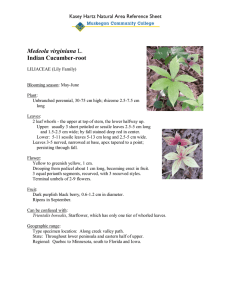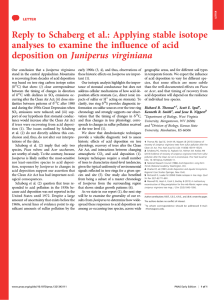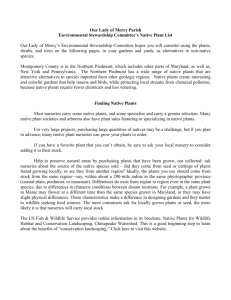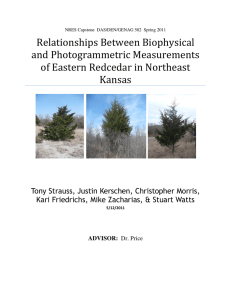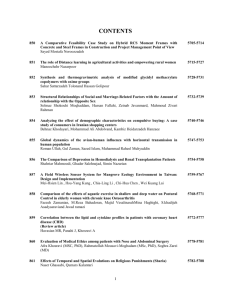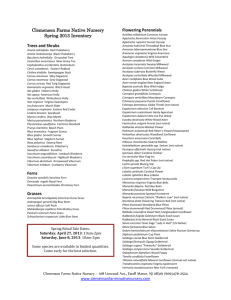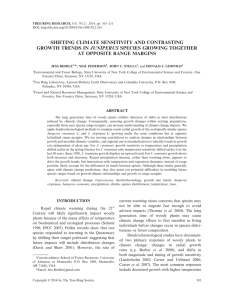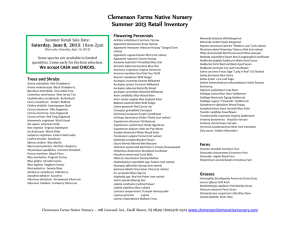The Susceptibility of Native Grasslands to Woody Plant Encroachment: A... Virginiana Kansas State University
advertisement
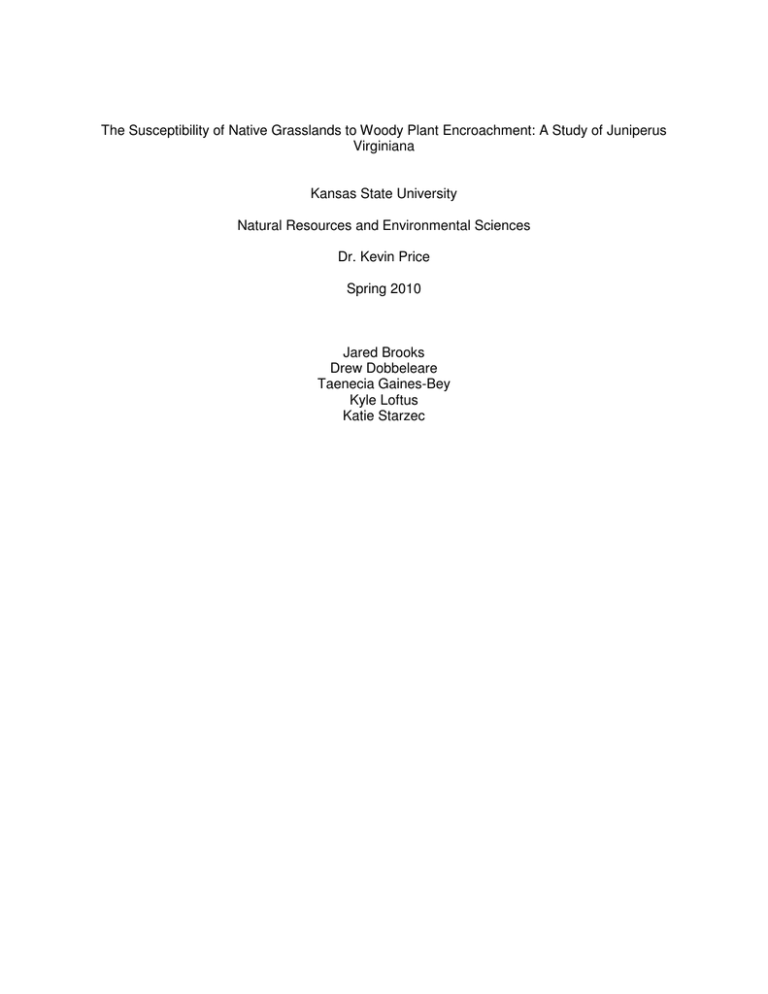
The Susceptibility of Native Grasslands to Woody Plant Encroachment: A Study of Juniperus Virginiana Kansas State University Natural Resources and Environmental Sciences Dr. Kevin Price Spring 2010 Jared Brooks Drew Dobbeleare Taenecia Gaines-Bey Kyle Loftus Katie Starzec Abstract Eastern redcedar (Juniperus virginiana) is a native tree species to North America, and is found throughout Kansas and the central Great Plains. Recent studies show that redcedar is invading prairie ecosystems and lowering biodiversity across native grasslands. Redcedar is also lowering understory cover and other plant species density where encroaching into the prairie. The redcedar is an evergreen that usually grows in a pyramidal or columnar shape. The foliage is usually green, sometimes having a slight tinge to the foliage of brown in the winter. This species can grow on all types of soil from clay to sand and on soils that are either acidic or alkaline. Redcedar is drought tolerant and this tree can be found growing almost anywhere. Redcedar is also classified as an invasive species. Two study sites were selected to represent a more recent redcedar invasion (less than 15 years and low tree density and basal area) and an older invasion site (greater than 50 years with high tree density and basal area). One of the sites was on the Konza Prairie and the other was just north of Randolph, Kansas. The study site with less tree density was at Konza and was a watershed named K20A that is located in the northern part of Konza and is burned on a 20year burn cycle. Primary vegetation at this site is grass with some forbs. The other study site with more tree density was above Randolph, called the Randolph site, is about one mile north of Randolph on 24 highway. This study site consisted of mostly redcedars that are fifty or greater years old. No means of control have been used here for many years and the understory of this forest had little other species. A few mosses and other small shrubs were all that existed under the redcedars. Our results show that Eastern redcedar is increasing in density in Kansas prairies from research that we have studied. Invasion of redcedar has been estimated to be 56.9 trees per hectare per year (reference??). When redcedar become more abundant than grass and begin to take over, they decrease the amount of plant species growing under them and lower biodiversity according to our sources and data. There are more plant species found in native prairie than in redcedar forest. In order to control this problem, proper management techniques need to be taken to prevent further invasion. Our literature review shows that with proper control, Eastern redcedar can be kept under control and not pose a problem. Introduction A land cover change that could have the potential to be detrimental to the prairie grasslands is the change from grasslands to woody plant species. One main woody species that has received great attention is Juniperus virginiana. Has the Juniperus virginiana, or better known as the Eastern redcedar, in fact increased its invasion in the native grasslands of Kansas over the last 20 years? According to a Kansas Forest article, “since 1965 Eastern redcedar volume has increased by 23,000 percent, which presents an opportunity for forest products but also concerns about woody encroachment into grasslands and changing wildlife habitat.” Even though it is a tree it is seen as an invasion and hazard to the natural vegetation in Eastern Kansas especially on the natural prairie grasses. How could such a thing as a tree become a problem? Why would anyone care if too many trees grow in an area? In order to truly understand why anyone would call a tree an invader of an area, some very important issues need to be addressed about the eastern redcedar tree. But how would anyone prove a tree is an outsider invader? First it is imperative to define just what an invasive species is. Secondly it is also very 2 beneficial to know what this tree does to the understory and vegetation that are in its vicinity, and why this is a large problem for prairie grasslands and cattle grazers. There are many ways to eradicate this tree but there are only a few effective ways to do it, some of which are tricky to execute. An invasive species can be a plant, an animal or other living organism such as microbes. What exactly is an invasive species one may ask? According to the U.S Fish and Wildlife Service an invasive species is defined as something that is “non- native (or alien) to the ecosystem under consideration; whose introduction causes or is likely to cause economic or environmental harm or harm to human health.” According to this definition it is possible for a plant such as a tree to be considered an invasive species. “Invasive species are one of the largest threats to our terrestrial, coastal and freshwater ecosystems, as well as being a major global concern” (EPA). Since it is an invasive species a good question to ask is how did it spread to become such a large problem. The Eastern redcedar can spread very rapidly in little time. According to an article written in the journal of Mammalogy: “through the lack of cedar management and the urbanization of prairies, the eastern red cedar has a strong influence on ecological processes and biodiversity and biogeochemical cycles.” According to Owensby, Blan, Eaton, Russ; “red cedar seeds are spread by various species of birds.” Since birds travel everywhere it makes these trees even easier to spread, and it decreases the time needed for an invasion. Humans help to increase spreading by planting the trees and using them as landscaping plants in order to make the lands look appealing enough to sell. “Red cedar forest cover was positively correlated with human population growth and concurrent housing development (Briggs, Hoch and Johnson).” This tree invasion effects everyone, not just individuals who reside in the Great Plains prairie grasslands. According to an article written in the journal of Mammalogy “It outcompetes forage species in pastures and is less efficient at converting carbon dioxide when compared to grasses.” This is a major problem for everyone considering that one of the main terrestrial places that carbon dioxide is stored is in vegetation. Not only does it not sequester carbon well it burns extremely fast because of its natural oils within the tree itself. This causes large and sometimes uncontrolled and unmonitored burns; especially if the weather conditions are dry. Devastating damage from a prairie grassland fire can be done to nearby farms, livestock and estates which cause problems for humans. Another thing that humans especially despise is small mammals such as rodents. The eastern redcedar makes a happy home for rodents. According to the journal of Mammalogy “it impacts small mammals especially rodents and it is easily spread to urban areas by birds as they consume the berries and relocate the seeds to new areas.” The spread of this tree does not have to be exclusive to the Great Plains grassland area in Eastern Kansas. It can be anywhere the berries are carried and excreted. These are some of the main reasons why everyone should care about the invasion of the eastern redcedar tree. As it not only affects the grasslands, but it has the potential to effect the outskirts of the grassland area. Ranchers and farmers should care because once an area is invaded by the tree it destroys the grasses and forbs the cattle graze on. The prairie grasslands can be a great place to graze cattle provided there is something for them to graze. The Eastern redcedar destroys understory cover. Meaning the grasses, forbs, and other life that is under the cover of these trees cannot flourish because the redcedar consumes a substantial amount of nutrients that otherwise would be consumed by grasses. “Beneath the red cedar canopy, virtually all grassland species were eliminated and richness was 3 very low often fewer than four species per 10 m plot. In contrast, plots adjacent to red cedar stands had as many as 35 herbaceous species (Briggs, Hoch, and Johnson).” According to John Briggs, Greg Hoch and Loretta Johnson, “when tallgrass prairie was converted to red cedar forest, herbaceous species diversity and productivity were drastically reduced and most grassland species were virtually eliminated. Also the red cedar can expand and convert tallgrass prairie to a closed canopy forest in as little as 40 years.” An herbaceous species includes any plants without a woody stem. They make up most of the species that you will find on the forest floor. This is a large problem that has been studied for many years, but with few resolutions to eradicate the problem. Many scientists, ecologists, biologists, farmers and ranchers have studied this invasion problem and all have come up with a few solutions to help manage an already invaded area. One of the main solutions that have been agreed upon throughout all of their research is that “active management is required to reduce populations, and to prevent invasion by maintaining vigor of grassland species” (Converse). Burning has proven to be an efficient way to manage a threatened area or an area that has already been affected by invasion. “Prescribed fire is a necessary tool if tree invasion is to be kept in check. The cedar trees must be burned or new shoots will germinate and actually exacerbate, rather than improve, the situation” (U.S. Fish & Wildlife Service). Clenton Owensby, Kenneth Blan, B,J Eaton and O.G Russ, discovered that burning the area was a sufficient way in eradicating the area of red cedars. “One Pasture was burned April 24th. Range Condition was excellent and the area had an abundance of mulch.” Another popular management procedure is to wait for the growing season cattle stocking rates. “Red cedar invasion rate generally declined as growing season (May-October) cattle stocking increased. The 1963 red cedar invasion rate declined 6.3 trees per acre per animal unit mount of additional grazing” (Ownesby, Blan, Eaton, Russ). In summary the more redcedar trees that are in an area the greater substantial reduction there is in the vegetation that is below and around the trees, which can be detrimental because there is a lack in biodiversity for that specific area. In addition to redcedar invasion creating a lack of biodiversity, it converts lands that can be grazed by cattle into woody forest; which can be no use to farmers and ranchers trying to graze cattle. Through literary research, diagrams, charts and field work; the main goal of our research was to answer these four question; are eastern redcedar densities increasing in the native grasslands of Kansas, and if so at what rate are eastern redcedars invading grasslands in Kansas? What is the future rate of growth if prairies remain untreated? What is the relationship between tree cover and understory cover? Background Although commonly referred to as the Eastern redcedar, Juniperus virginiana is actually a member of the Juniper family. It is native to Kansas as well as 37 other states, and can be found all throughout the Great Plains in one form or another. The tree was first observed at Roanoke Island, Virginia in 1864. The tree was prized by colonists for building furniture, fences, and log cabins. In the years since then the tree has been cultivated in the dust bowl era as a cost effective windbreak for helping to control soil erosion, which is how the tree first spread throughout the state of Kansas. Originally, just male trees were planted, but due to great demand for the trees, female trees were used in conjunction with male trees in the windbreaks, enabling them to propagate beyond just the original planting sites. Some physical characteristics of Eastern Red Cedar are that it will grow up to ninety feet tall, but the average tree size tends to be around 30 feet tall. The tree prefers moist soil with a pH between 6 and 8. Mature trees tend to be intolerant of shade, but young trees grow and thrive in shaded areas. 4 One of the critical weaknesses of the tree is that young trees are fire intolerant, allowing fire to be used as a cost effective control mechanism in young tree stands. Mature trees are not typically killed by fire. Study Area This study was performed on Konza Prairie Watershed K20A and a section of forest located one mile north of Randolph, Kansas. The Konza Prairie is a 3,487 hectare native tallgrass prairie preserve, located in the Flint Hills region of northeast Kansas (39º05’N, 96º35’W). Due to steep slopes and shallow limestone soils, the Flint Hills contain the largest remaining area of unplowed prairie in the United States. The prairie extends from the NebraskaKansas border south to northeastern Oklahoma. The Konza Prairie serves as a long-term study site for ecological patterns and processes. The prairie is studied on a watershed level and incorporates various fire and grazing regimes for each watershed. Watershed K20A is located in the northern portion of the Konza Prairie, and is burned on a 20-year burn cycle. The following figures show the location of Watershed K20A in the Konza Prairie and an aerial image of the K20A study site. Figure 1. Konza Prairie Watershed Management Units 5 Figure 2. Aerial Photo of K20A Study Site The approximate age of the K20A redcedar stand is estimated to be less than ten years old. A transect, approximately 100 meters in length, was located on the site from the coordinates 39.10729˚N, 96.57464˚W to 39.1697˚N, 96.57545˚W. From our field analysis on this transect, we found the mean basal area to be 16.1 square centimeters, the mean distance between trees to be 8.86 meters, the absolute density to be 127 redcedars per hectare, and the total basal cover to be 0.2 square meters per hectare. The primary vegetation of the K20A study site consisted of native, perennial C4 grasses, sub-dominant grasses, forbs, and woody species. The predominant vegetation along this transect was grasses and grass likes (approximately 96.25% of understory cover). Other species of understory cover included 3.75% forbs and 2.75% shrubs. The study area also included a stand of redcedars located approximately one mile north of Randolph, KS. This stand of redcedars has not been burned for numerous years and our coring samples suggest that the stand is over 50 years old. A transect, approximately 100 meters in length, was located on the site from the coordinates 39.10729˚N, 96.57464˚W to 39.1697˚N, 96.57545˚W. From our field analysis along this transect, we found the mean basal area to be 299 square centimeters, the mean distance between trees to be 2.04 meters, the absolute density to be 2403 redcedars per hectare, and the total basal cover to be 71.8 square meters per hectare. The predominant understory cover along this transect was redcedar litter (approximately 64.17% of understory cover). Other understory cover included 17.22% shrubs and 4.72% moss/lichens. The following figures illustrate the location of the Randolph study site. 6 Figure 3. County Level Map Showing Randolph, KS Figure 4. Aerial Image of Study Site North of Randolph, KS Methods Aerial imagery and field work are tools the group used to gather data. Analyzing aerial imagery from the past and present illustrates rates of invasion. Field work, including the Pointcentered Quarter sampling method, Daubenmire quadrats, tree increment boring, and densitometer readings give a ratio of tree cover vs. understory cover, the average age of the trees in the study areas, and the average percent canopy cover. For the site in Randolph, we acquired arial photographs from Google Earth, years 1991, 2002, 2005, two from 2006, and 2010. For the Konza K20A study site, we compared photos from years 2005, two from 2006, 2007 and 2010. We traveled to Konza K20A and the site at Randolph to collect data relating to tree cover vs. ground cover. This was done using the Point-Centered Quarter sampling method and the 7 Daubenmire Quadrat Method. The Point-Centered Quarter sampling method measures the approximate density of plant species in the study site. Kevin Mitchell from Hobart and William Smith Colleges says that materials needed are a 100-meter tape, and shorter 5-10 meter tape, paper to take notes, a calculator, a compass, and a table of random numbers to determine the distances along the transect that measurements will be taken from (Mitchell, 2007). For our study, we chose areas within the study site that would give the best representation of lower density to higher density tree stands. At both sites, we laid out a 100-meter transect and took measurements at each 10-meter interval. At each 10-meter interval on the 100-meter tape, the station was divided into quarters; a northeast, southeast, northwest, and southwest quarter. Data recorded included: 1. the distance from the 10-meter interval to the nearest redcedar tree in each quarter, using the smaller measuring tape 2. the species of the tree (which in our case was always Juniperus virginiana) 3. the diameter of each tree trunk at breast height (DBH) (Mitchell, 2007) Figure 5. Jared Brooks measuring trunk diameter at Konza. The Daubenmire quadrats method goes along with the Point-Centered Quarter sampling method by estimating ground cover. Materials needed include Daubenmire data worksheets and two colored polls. Along the same transect at each 10-meter station, the two stakes are laid on the ground at right angles, creating a 2-sided “L” box. The type of groundcover within the box is estimated visually. Options for cover, or plant life forms, are grasses and grass likes, forbs (broadleaf or herbs), shrubs, bare ground, litter, rock, and mosses or lichens. Percentage cover of each plant life form or non-living components is estimated, and given a rating: 1 = 1-5% 2 = 6-25% 8 3 = 26-50% 4 = 51-75% 5 = 76-95% 6 = 96-100% (Price, 2010) Figure 6. Drew Dobbeleare estimating ground cover at the Randolph study site using Daubenmire Quadrat Method. Percent groundcover and type of ground cover can then be compared to the density of the redcedars, with the intent of illustrating how redcedar growth affects understory growth. Tree core samples, extracted using a boring tool, were collected from the five trees that seemed to be the oldest along the transect at the Randolph site. Materials needed were the increment borer, drinking straws to temporarily store the samples, and notepaper. The core samples were analyzed by counting the tree rings to find the approximate age of the forest. At the Konza K20A site, the tree trunks were not large enough to take samples from with the borer, so we estimated the trees’ ages. 9 Figure 7. Taenecia Gaines-Bey getting a tree core sample at the Randolph site. The densitometer measures overhead tree canopy (Price, 2010). Materials needed were the densitometer and notepaper. The tool is a concave mirror in a small box, with a circular grid pattern on the mirror. Held at elbow length away from the body, pointed toward the sky, the tool instructs the reader to picture four imaginary dots in each square on the grid, and count which dots reflect sky instead of canopy cover. Four measurements were taken at each station and averaged. The densitometer, which we acquired from Professor Kevin Price, came with its own math instructions: the number of dots is then multiplied by 1.04 and subtracted from 100 to give percent canopy cover. This method was used at the Randolph site, but the Konza site did not have any overhead canopy, so it was not used. Figure 8. Katie Starzec using the densitometer at the Randolph site. 10 Figure 9. The densitometer measures percent canopy cover. Analysis of results was preformed using Microsoft Excel, and univariable analysis was used to compute the mean, standard deviation, and linear regression of the data. Linear regression was used to look at relationships among variables. Data Analysis / Results Table 1. Calculated Importance Values Using the Point-Center Quarter Method Site: Randolph Juniperus Virginiana K20A Juniperus Virginiana Mean BA (cm^2) 299 16.1 Num per ha 2403 127 Rel. Density 100 100 Rel. Cover 100 100 Rel. Frequency 100 100 Importance 300 300 Points 10 10 2.04 m 8.86 m Absolute Density 2403 per ha 127 per ha Total Cover 71.8 m^2/ha 0.2 m^2/ha Species: Mean Distance 11 Table 2. Influence of Redcedar Density on Understory Cover Site Absolute Density (per ha) % Grass Cover % Forb Cover K20A Randolph 127 2403 96.25 0 3.75 0 % Shrub Cover 2.75 17.22 % Litter % Moss / Lichens 0 64.17 0 4.72 120 100 Percent Cover 80 Shrubs Forbs (broadleaf or herbs) Grasses and grass likes Moss/Lichens Shrubs Litter (ground and standing) 60 40 20 0 K20A Randolph Study Site Figure 10. Predominant Forms of Understory Cover As shown in Figure 10, the predominant forms of understory cover on each study site. Study site K20A consists predominantly of grasses and grass likes, while the majority of the Randolph study site understory cover is litter. 12 Figure 11, below, illustrates the correlation between redcedar numbers and other plant species present. 120 Understory Cover (% cover) 100 80 Grasses and grass likes Forbs Shrubs Litter Moss/Lichens 60 40 20 0 0 500 1000 1500 2000 2500 3000 Absolute Redcedar Density (redcedars per ha) Figure 11. Effect of Redcedar Density on Understory Cover As shown in Figure 11, when more cedars are present, the number of other plant species decreases. Grasses and forbs become less abundant with more tree cover. Moss/lichens, shrubs, and ground litter become more abundant with more tree cover. Table 3. Percent Overhead Canopy Cover Densitometer Data Average % Transect Location Canopy 0 80.76 10 89.6 30 92.46 50 94.54 70 93.24 90 94.02 Densitometer Data 13 The percent overhead canopy was calculated at six spots along the transect at the Randolph site. The overhead canopy cover did not change significantly along the transect, but it did increase slightly from the 0 station to the 90 station. Percent sky would be the difference between average percent canopy and 100 (for example, at transect location 0, average percent viewable sky would be (100-80.76 = 19.24%). Table 4. Tree Coring Data Coring Data Location Average age (in years) K20A Randolph 10 61 Absolute Density (per ha) 127 2403 3000 Absolute Density (redcedars per ha) 2500 2000 1500 1000 500 0 0 10 20 30 40 Age (years) 50 60 70 Figure 12. Effect of Forest Age on Redcedar Density Figure 12 shows the correlation between redcedar density and the age of the trees. As trees become denser, the age of the trees goes up. Younger stands of trees are not that dense. Older stands of trees are very dense. As the redcedar begins to invade and take over, they will become denser and when they become dense will become an old stand without an intervention. 14 200 180 160 Redcedar (NO. Trees/Acre) 140 120 Heavy Light 100 80 60 40 20 0 58 59 60 61 62 63 64 65 66 67 68 69 Years Figure 13. Population Growth Rate of a Stand of Redcedars Over 10 Years (data adapted from “Evaluation of Eastern Redcedar Infestations in the Northern Kansas Flint Hills”) This graph shows the rate at which the population of redcedar grows over the time of a 10-year period. The growth of the heavy population grows much more over the 10-year period than that of the light population. The number of trees is much more over this period than that of the light population. The heavy population takes a steep climb in the number of trees over the 10-year period, whereas the light population stays on a steady growth rate over this period. Conclusion From our research on Konza Prairie and the Randolph site we have been able to collect data on the redcedar. We had several questions we wanted to answer in the process of doing our research: Are eastern redcedar densities increasing in the native grasslands of northeastern Kansas? At what rate are eastern redcedars invading grasslands on the Kansas? What influence does land management have on dispersal rates? What is the future rate of growth if prairies remain untreated? What is the relationship between tree cover and understory cover? Our hypothesis for this research was that Redcedar (Juniperus virginiana) densities (percent land cover) have increased in the native grasslands of northeastern Kansas over the last 20 years. Are eastern redcedar densities increasing in the native grasslands of northeastern Kansas? From the data we collected and have read from others it would appear that Eastern redcedar densities are increasing in native Kansas grasslands. Prairie is being invaded by more redcedar and the density of trees goes up as the trees take over. Older stands have a higher 15 density of trees than younger stands. As time progresses the trees gradually turn prairie into closed canopy forest. At what rate are eastern redcedars invading grasslands on the Kansas prairie? Eastern redcedar has been invading Kansas’s prairies at a rate of 56.9 trees per hectare per year. We arrived at this number from the data we collected in our study. The growth of redcedars is not linear. Rather the growth seems to peak half way through the cycle that Owensby uses. We also have data from a report done by the Oklahoma Redcedar Taskforce that shows that redcedars are invading at a rate of 300,000 acres per year in Oklahoma (Redcedar Taskforce). These two results show that redcedar is invading prairie and at a steady rate. What influence does land management have on dispersal rates? Proper land management has a big impact on the dispersal rate of redcedar. When prairie is properly managed, redcedars cannot become established in them. Proper burning regimes done yearly help to reduce the risk of cedar invasion, cedars can’t stand fire when they are young. Good grazing practices also help keep cedars from invading the prairie. If properly grazed, grass will grow better and denser than in poor prairies and will help keep cedars from establishing. Proper control is a major factor in preventing the spread of Eastern redcedar. What is the future rate of growth if prairies remain untreated? The future rate of growth if left untreated can be projected to be the same as current growth rates. We found that Eastern redcedar is invading Kansas’s prairie at a rate of 56.9 trees per hectare per year. If left untreated this rate will continue as is or even increase with the lessening of proper management techniques. In order to control the future invasion of redcedar we must use proper management techniques to control their spread. What is the relationship between tree cover and understory cover? The relationship shown by data collected is that when there are more trees, the understory cover decreases. In open prairie there is a lot of understory and more diversity of plant species found. As grasslands and prairies begin to be converted into closed canopy redcedar forests, the species diversity of plants in the understory drops. In closed canopy forest there are very few plants that grow, a few small forbs, and lichens and mosses grow in the understory. There is more litter on the forest floor than plants growing. There is more diversity of understory cover in the prairie setting with more plants present, than in redcedar forest. Discussion The following photographs are taken from Google Earth depicting aerial redcedar tree density and how it increases over time either around or along our transect. 16 April 4, 2010 current conditions on Randolph Site March 30 2010 current urrent conditions on K20A site 17 Literature Cited Briggs, John; Hoch, Greg; Johnson, Loretta. "Assessing the Rate Mechanisms and Consequences of the Conversion of Tallgrass Prairie to Juniperus Virginiana Forest." Ecosystems (2002): 578-586. Converse, Carmen. "Global Invasive Specied Team." 18 July 1983. Invasive.org. 21 Janurary 2010 <http://www.invasive.org/gist/esadocs/documnts/junivir.pdf>. Department of the Interior. "Invasive Species." April 2007. U.S Fish & Wildlife service. 21 January 2010 <http://www.fws.gov/mountain-prairie/pfw/r6pfw15.htm>. EPA. “Oceans, Coasts, Estuaries.” 24 July 2008. Invasive Species. 7 April 8, 2010 <http://www.epa.gov/owow/invasive_species/> Gilman, Edward and Watson, Dennis. "Juniperus Virginiana Eastern Redcedar." 20 September 1993. U.S Department of Agriculture. 30 April 2010 <http://hort.ufl.edu/trees/JUNVIRA.pdf>. Horncastle, Valerie; Hellgren, Eric; Mayer, Paul; Ganguli, Amy; Engle David. (2005). “Implicatioins of invasion by Juniperus Virginiana on Small Mammals in the Southern Great Plains. Journal of Mammalogy, 86(6), 1144-1155 Mitchell, Kevin. Quantitative Analysis by the Point-Centered Quarter Method. June 25, 2007. Hobart and William Smith Colleges. Moser, Keith; Hansen, Mark; Atchison, Robert; Brand, Gary; Butler, Brett; Crocker, Susan; Meneguzzo, Dacia; Nelson, Mark; Perry, Charles; Reading, William; Wilson, Barry; and Woodall, Christopher. Kansas Forest. Manuscript. Newtown: USDA Forest Service, 2008. Owensby, Clenton; Blan, Kenneth; Eaton, B.J; and Russ, O.G. "Evaluation of Eastern Redcedar Infestations in the Northern Kansas Flint Hills." Range Management (1973): 256-259. Redcedar Task Force. “A Strategy for Control and Utilization of Invasive Juniper Species in Oklahoma.” December 11, 2002. USDA. "Plants Profile." Natural Resources Conservation Service. 3 May 2010 <http://plants.usda.gov/java/profile?symbol=JUVI>. 18 Appendix A: PCQM Data Transect 1 - K20A Date: 3/29/2010 Recorders: Starzec/Brooks Time: 2:30 PM Sky Conditions: mostly sunny/windy Initial Point: Lat. 39.10728, Long. 96.57464 Final Point: Lat. 39.1697, Long. 96.57545 Distance (m) 0 Quadrat 1 10 2 20 3 30 4 40 5 Quarter 1 (NE) 2 (SE) 3 (SW) 4 (NW) 1 2 3 4 1 2 3 4 1 2 3 4 1 Species Juniperus Virginiana Juniperus Virginiana Juniperus Virginiana Juniperus Virginiana Juniperus Virginiana Juniperus Virginiana Juniperus Virginiana Juniperus Virginiana Juniperus Virginiana Juniperus Virginiana Juniperus Virginiana Juniperus Virginiana Juniperus Virginiana Juniperus Virginiana Juniperus Virginiana Juniperus Virginiana Juniperus Virginiana Distance (ft) Distance (m) DBH (in) DBH (cm) Avg. Distance 26.5 8.0772 2 5.08 9.57834 39.3 11.97864 0.5 1.27 36.6 11.15568 2.5 6.35 23.3 7.10184 1 2.54 24.3 7.40664 1 2.54 9.25068 28.2 8.59536 2.5 6.35 34.6 10.54608 3 7.62 34.3 10.45464 0.5 1.27 33.3 10.14984 0.5 1.27 9.25068 16.4 4.99872 3 7.62 42.3 12.89304 2.5 6.35 29.4 8.96112 0.25 0.635 8.6 2.62128 0.25 0.635 8.382 27.5 8.382 2.5 6.35 61.7 18.80616 1 2.54 12.2 3.71856 1 2.54 9.8 2.98704 1.25 3.175 8.89254 19 50 6 60 7 70 8 80 9 90 10 2 3 4 1 2 3 4 1 2 3 4 1 2 3 4 1 2 3 4 1 2 3 4 Juniperus Virginiana Juniperus Virginiana Juniperus Virginiana Juniperus Virginiana Juniperus Virginiana Juniperus Virginiana Juniperus Virginiana Juniperus Virginiana Juniperus Virginiana Juniperus Virginiana Juniperus Virginiana Juniperus Virginiana Juniperus Virginiana Juniperus Virginiana Juniperus Virginiana Juniperus Virginiana Juniperus Virginiana Juniperus Virginiana Juniperus Virginiana Juniperus Virginiana Juniperus Virginiana Juniperus Virginiana Juniperus Virginiana 44.8 32.3 29.8 22 21.4 30.8 29.8 39.3 5.7 25.1 14.3 20.3 10.8 13 20.6 26.3 25.8 66 32.2 43.6 43.2 34.3 43.2 13.65504 9.84504 9.08304 6.7056 6.52272 9.38784 9.08304 11.97864 1.73736 7.65048 4.35864 6.18744 3.29184 3.9624 6.27888 8.01624 7.86384 20.1168 9.81456 13.28928 13.16736 10.45464 13.16736 2.5 1 1.5 1.5 0.5 0.25 3 3 0.25 2.25 0.25 0.25 2.25 2.25 2.25 2.25 2.5 1.3 1.2 1.2 2.15 1.2 1.2 6.35 2.54 3.81 3.81 1.27 0.635 7.62 7.62 0.635 5.715 0.635 0.635 5.715 5.715 5.715 5.715 6.35 3.302 3.048 3.048 5.461 3.048 3.048 7.9248 6.43128 4.93014 11.45286 12.51966 20 Transect 1 - Randolph Date: 4/5/2010 Recorders: Starzec/Brooks Time: 2:30 PM Sky Conditions: mostly sunny/windy Initial Point: Lat. 39.45969, Long. 96.75520 Final Point: Lat. 39.45997, Long. 96.75404 Distance (m) 0 Quadrat 1 10 2 20 3 30 4 40 5 Quarter 1 (NE) 2 (SE) 3 (SW) 4 (NW) 1 2 3 4 1 2 3 4 1 2 3 4 1 2 3 4 Species Juniperus Virginiana Juniperus Virginiana Juniperus Virginiana Juniperus Virginiana Juniperus Virginiana Juniperus Virginiana Juniperus Virginiana Juniperus Virginiana Juniperus Virginiana Juniperus Virginiana Juniperus Virginiana Juniperus Virginiana Juniperus Virginiana Juniperus Virginiana Juniperus Virginiana Juniperus Virginiana Juniperus Virginiana Juniperus Virginiana Juniperus Virginiana Juniperus Virginiana DBH Avg. Distance (ft) Distance (m) (in) DBH (cm) Distance 2.08 0.633984 13.8 35.052 2.032254 7.17 2.185416 0.5 1.27 7.17 2.185416 14.5 36.83 10.25 3.1242 1 2.54 3.17 0.966216 14 35.56 2.763012 6.67 2.033016 10.5 26.67 13.42 4.090416 7.5 19.05 13 3.9624 7 17.78 5.75 1.7526 7 17.78 2.394204 9.33 2.843784 9.8 24.892 14.92 4.547616 11 27.94 1.42 0.432816 6 15.24 7.25 2.2098 6.8 17.272 2.539746 7.58 2.310384 1.4 3.556 10.25 3.1242 8.2 20.828 8.25 2.5146 6.4 16.256 8.33 2.538984 8.5 21.59 1.892046 10.5 3.2004 9.3 23.622 4.83 1.472184 6.2 15.748 1.17 0.356616 1.1 2.794 21 50 6 60 7 70 8 80 9 90 10 1 2 3 4 1 2 3 4 1 2 3 4 1 2 3 4 1 2 3 4 Juniperus Virginiana Juniperus Virginiana Juniperus Virginiana Juniperus Virginiana Juniperus Virginiana Juniperus Virginiana Juniperus Virginiana Juniperus Virginiana Juniperus Virginiana Juniperus Virginiana Juniperus Virginiana Juniperus Virginiana Juniperus Virginiana Juniperus Virginiana Juniperus Virginiana Juniperus Virginiana Juniperus Virginiana Juniperus Virginiana Juniperus Virginiana Juniperus Virginiana 2.08 7.58 4.08 4.75 9 8 7.08 3.08 8.83 6.42 4.33 12.08 6.08 4 4.17 4 2.5 2.42 8.17 6.42 0.633984 2.310384 1.243584 1.4478 2.7432 2.4384 2.157984 0.938784 2.691384 1.956816 1.319784 3.681984 1.853184 1.2192 1.271016 1.2192 0.762 0.737616 2.490216 1.956816 4.4 7.2 4.7 3.4 13.3 2.5 1.8 10.4 9.5 2 3.8 8.5 13.6 1 1.3 3.2 4 1.5 4 8.8 11.176 18.288 11.938 8.636 33.782 6.35 4.572 26.416 24.13 5.08 9.652 21.59 34.544 2.54 3.302 8.128 10.16 3.81 10.16 22.352 1.408938 2.069592 2.412492 1.39065 1.486662 22 Appendix B: Daubenmire Data Study Site: K20A Plots: Species Plants by Life Forms: Grasses and grass likes Forbs (broadleaf or herbs) Shrubs Overstory Cover Non-living Components: Bare ground Litter (ground and standing) Rock Moss/Lichens 1 2 3 97.5 97.5 2.5 2.5 0 Stan. Average Dev. 4 5 6 7 8 9 10 85 97.5 97.5 97.5 97.5 97.5 97.5 97.5 96.25 3.75 2.5 2.5 0 2.5 15 0 2.5 2.5 0 2.5 2.5 0 2.5 0 0 2.5 0 0 2.5 0 0 2.5 2.5 0 15 0 0 3.75 2.75 0 3.75 4.25 0 0 0 0 0 0 0 0 0 0 0 0 0 0 0 0 0 0 0 0 0 0 0 0 0 0 0 0 0 0 0 0 0 0 0 0 0 0 0 0 0 Study Site: Randolph Plots: Species Plants by Life Forms: Grasses and grass likes Forbs (broadleaf or herbs) Shrubs Overstory Cover Non-living Components: Bare ground Litter (ground and 1 2 3 4 5 6 7 8 Stan. Average Dev. 9 0 0 0 0 0 0 0 0 0 0 0 0 0 80.76 0 15 89.6 0 2.5 0 2.5 92.46 0 97.5 0 37.5 94.54 0 0 0 0 93.24 0 0 0 17.222 90.12 0 30.697 5.54 0 97.5 0 62.5 0 85 0 62.5 0 0 0 37.5 0 37.5 0 97.5 0 97.5 64.167 32.167 23 standing) Rock Moss/Lichens Appendix C: Densitometer Data 0 0 0 0 0 0 0 2.5 0 0 0 0 0 37.5 0 0 0 2.5 0 4.7222 0 11.634 Densitometer Data Location 0 10 30 50 70 90 Quadrat 1 2 4 6 8 10 Location 0 10 30 50 70 90 Quadrat 1 2 4 6 8 10 N 17 11 8 7 10 3 Direction E S 13 20 7 8 7 6 5 6 5 4 11 5 W 24 14 8 3 7 4 Percent Canopy (%) N E S W Average 82.32 86.48 79.2 75.04 80.76 88.56 92.72 91.68 85.44 89.6 91.68 92.72 93.76 91.68 92.46 92.72 94.8 93.76 96.88 94.54 89.6 94.8 95.84 92.72 93.24 96.88 88.56 94.8 95.84 94.02 Note: % cover calculations explained in methods section 24
